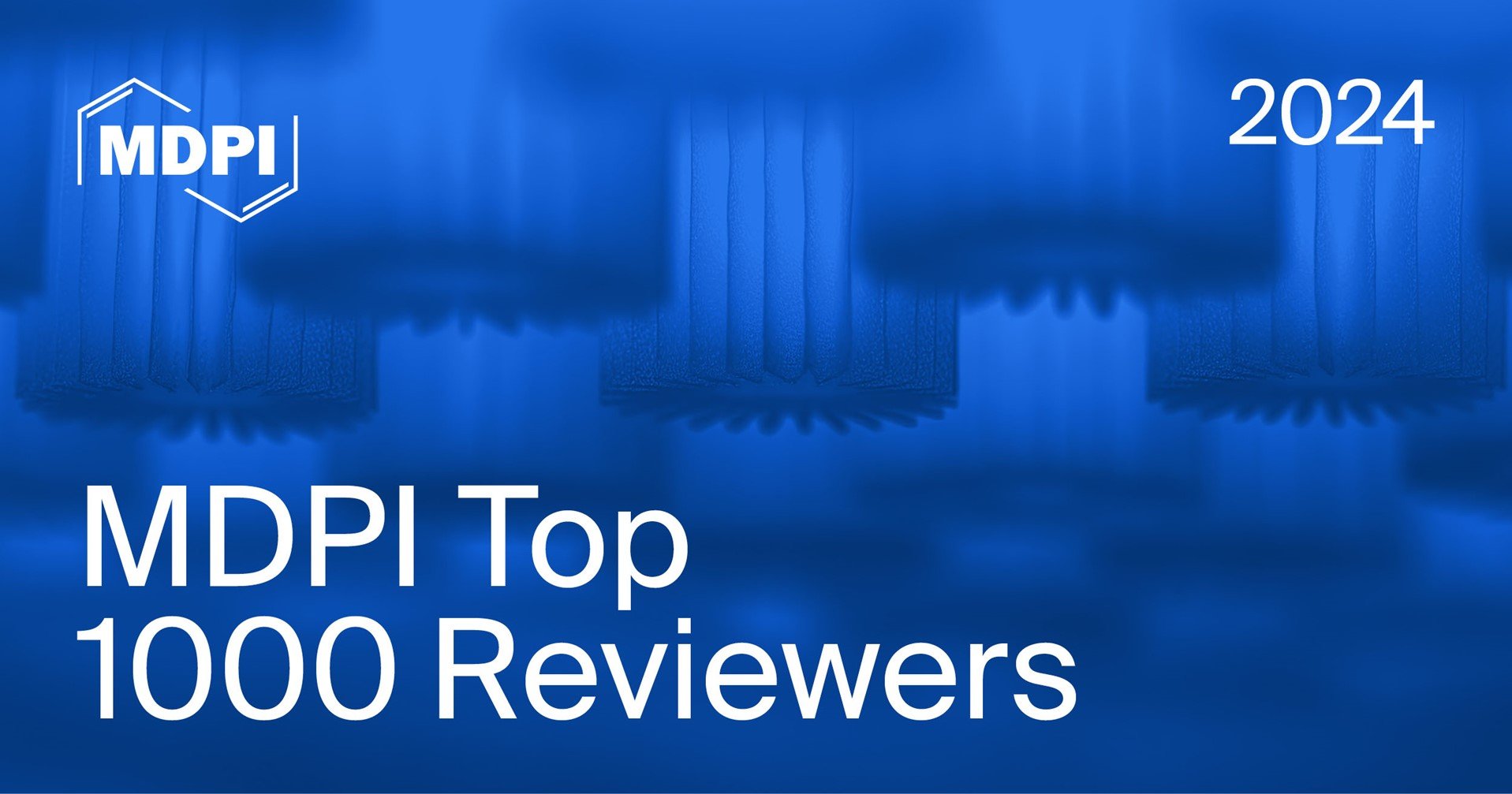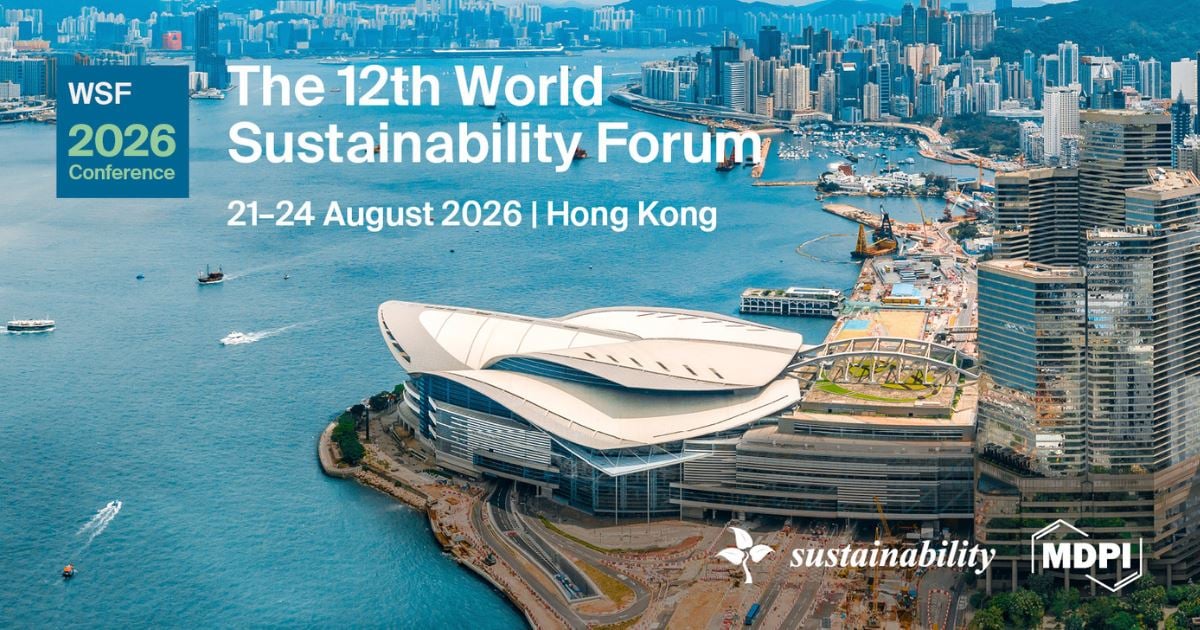Journal Description
Sustainability
Sustainability
is an international, peer-reviewed, open-access journal on environmental, cultural, economic, and social sustainability of human beings, published semimonthly online by MDPI. The Canadian Urban Transit Research & Innovation Consortium (CUTRIC), International Council for Research and Innovation in Building and Construction (CIB) and Urban Land Institute (ULI) are affiliated with Sustainability and their members receive discounts on the article processing charges.
- Open Access— free for readers, with article processing charges (APC) paid by authors or their institutions.
- High Visibility: indexed within Scopus, SCIE and SSCI (Web of Science), GEOBASE, GeoRef, Inspec, RePEc, CAPlus / SciFinder, and other databases.
- Journal Rank: JCR - Q2 (Environmental Studies) / CiteScore - Q1 (Geography, Planning and Development)
- Rapid Publication: manuscripts are peer-reviewed and a first decision is provided to authors approximately 19.3 days after submission; acceptance to publication is undertaken in 3.4 days (median values for papers published in this journal in the first half of 2025).
- Recognition of Reviewers: reviewers who provide timely, thorough peer-review reports receive vouchers entitling them to a discount on the APC of their next publication in any MDPI journal, in appreciation of the work done.
- Testimonials: See what our editors and authors say about Sustainability.
- Companion journals for Sustainability include: World, Sustainable Chemistry, Conservation, Future Transportation, Architecture, Standards, Merits, Bioresources and Bioproducts and Accounting and Auditing.
Impact Factor:
3.3 (2024);
5-Year Impact Factor:
3.6 (2024)
Latest Articles
Configuration Study on Production Equipment Operation Management and Control Performance in Industrial Internet Environment
Sustainability 2025, 17(21), 9890; https://doi.org/10.3390/su17219890 - 5 Nov 2025
Abstract
In the industrial internet environment, the operation and control of production equipment have become increasingly complex, and their performance directly affects the efficiency, benefits and sustainable development of manufacturing enterprises. From the three-dimensional perspective of “asset-application-maintenance”, this paper constructs a performance analysis framework
[...] Read more.
In the industrial internet environment, the operation and control of production equipment have become increasingly complex, and their performance directly affects the efficiency, benefits and sustainable development of manufacturing enterprises. From the three-dimensional perspective of “asset-application-maintenance”, this paper constructs a performance analysis framework for the operation and control of production equipment, systematically identifies the combination of core factors affecting performance, and fills the research gap in the current lack of empirical analysis from the configuration perspective in this field. On the basis of data from 82 manufacturing enterprises, the fsQCA method was used to identify three performance improvement paths: the high-load output mode, the lean management and control mode, and the low-failure operation mode. These paths clarify the equivalent approaches to achieve high performance in the operation and control of production equipment under the interaction of multiple factors. On this basis, the study demonstrates the operability and effectiveness of the proposed strategies in actual industrial scenarios through empirical verification in a manufacturing workshop of aero-engine transmission units. In contrast to existing studies, this study introduces the fsQCA method in the field of industrial equipment management and control for the first time to reveal the influencing paths; its originality and methodology have significant innovative significance. The research results provide new ideas and methodological guidance for enterprise managers to improve the performance of production equipment operations and controls in the industrial internet environment, which helps to enhance the sustainable development capability of manufacturing enterprises.
Full article
Open AccessArticle
Bridging the Accessibility Gap in Green Tourism: A Framework for Sustainable Integration of Specialised Off-Road Wheelchair Services with Public Transport Networks
by
Marcin Jacek Kłos and Marcin Staniek
Sustainability 2025, 17(21), 9889; https://doi.org/10.3390/su17219889 - 5 Nov 2025
Abstract
Reducing social exclusion through technology is a key challenge for sustainable development, particularly within the context of accessible tourism. This study, as part of the “MOUNTAINS WITHOUT BARRIERS” project, addresses this issue by aiming to identify optimal locations for specialized all-terrain wheelchair rental
[...] Read more.
Reducing social exclusion through technology is a key challenge for sustainable development, particularly within the context of accessible tourism. This study, as part of the “MOUNTAINS WITHOUT BARRIERS” project, addresses this issue by aiming to identify optimal locations for specialized all-terrain wheelchair rental stations in mountainous regions. The primary purpose is to ensure these locations are seamlessly integrated with existing local transport systems, fostering genuine accessibility. A dedicated methodology was developed to analyze the spatial integration of the accessible trail network with the transport system in the Beskid Agglomeration. The analysis, conducted using Geographic Information System (GIS) tools, considers access via both individual transport and public transport, with a clear emphasis on prioritizing the latter to promote sustainable mobility patterns. Applying this approach, the study identified potential station locations that are not only conveniently situated at trailheads but are also highly accessible via public transport. The main finding indicates that strategic placement can significantly minimize the necessity for private car usage. Integrating tourism infrastructure with public transport is crucial for increasing the real-world accessibility of mountain areas for people with disabilities. Furthermore, the results and methodology provide valuable recommendations that can serve as a practical input for Sustainable Urban Mobility Plans (SUMP).
Full article
(This article belongs to the Special Issue Inclusive Tourism and Its Place in Sustainable Development Concepts)
Open AccessArticle
Unraveling the Triple Nexus of the Digital Economy, Industrial Transformation, and Carbon Emissions: Evidence from China
by
Hongyuan Ding and Yuan Tian
Sustainability 2025, 17(21), 9888; https://doi.org/10.3390/su17219888 - 5 Nov 2025
Abstract
Achieving carbon neutrality is a global priority, and China’s “dual-carbon” goals place urgent demands on emission reduction. In this context, the digital economy and industrial structure transformation are key drivers of synergistic carbon mitigation and sustainable development. This study constructs an integrated analytical
[...] Read more.
Achieving carbon neutrality is a global priority, and China’s “dual-carbon” goals place urgent demands on emission reduction. In this context, the digital economy and industrial structure transformation are key drivers of synergistic carbon mitigation and sustainable development. This study constructs an integrated analytical framework, combining an improved three-system coupling coordination model, exploratory spatial data analysis, and panel vector autoregression, using panel data from 30 Chinese provinces between 2013 and 2022. The results reveal three main findings: (1) Spatial heterogeneity: The digital economy follows an “advanced East—catching-up Central—lagging West” pattern, while carbon emissions show a “higher North—lower South” gradient. (2) Improving coordination with regional disparities: Overall coupling coordination has steadily increased, but Eastern provinces exhibit stronger synergistic capabilities than Central and Western regions. (3) Bidirectional interactions and self-reinforcing effects: Digital economy development drives industrial structure upgrading, which in turn promotes long-term carbon reduction; all three systems display self-reinforcing dynamics. These findings provide robust empirical evidence on the complex co-evolution of digital economy, industrial transformation, and carbon emissions, offering actionable insights for policymakers to design region-specific strategies for coordinated low-carbon development.
Full article
Open AccessArticle
Machine Learning Methods Benchmarking for Predicting Flight Delays: An Efficiency Meta-Analysis
by
Hélio da Silva Queiróz Júnior, Viviane Falcão, Francisco Gildemir Ferreira da Silva, Izabelle Marie Trindade Bezerra and Joab Kleber Lucena Machado
Sustainability 2025, 17(21), 9887; https://doi.org/10.3390/su17219887 - 5 Nov 2025
Abstract
Predicting delays in commercial flights is an increasing challenge due to rising air traffic demand, which generates additional costs and operational complexity. This study synthesizes and evaluates machine learning approaches for flight delay predictions, aiming to identify the most accurate prediction logic and
[...] Read more.
Predicting delays in commercial flights is an increasing challenge due to rising air traffic demand, which generates additional costs and operational complexity. This study synthesizes and evaluates machine learning approaches for flight delay predictions, aiming to identify the most accurate prediction logic and assess the role of sample size in model performance. A systematic literature review was conducted, followed by a meta-analysis of 1077 studies published between 2015 and 2025. The studies were classified by prediction logic (binary classification or regression) and evaluated in terms of model effectiveness using Data Envelopment Analysis and Tobit regression to determine the influence of explanatory variables. The results show that binary classification approaches achieved higher average accuracy than regression models did, with confidence intervals validating their relative effectiveness. Furthermore, findings indicate that the use of more complex models does not guarantee improved predictive performance, suggesting that researchers should prioritize robust variable selection rather than constantly adopting increasingly complex methods. This work provides a comprehensive overview of machine learning methods for flight delay predictions and highlights implications for optimizing airport operations and enhancing passenger experience through the adoption of more reliable predictive strategies.
Full article
(This article belongs to the Special Issue Advances in Data-Driven Transportation Systems: Emerging Trends, Challenges, and Applications)
►▼
Show Figures
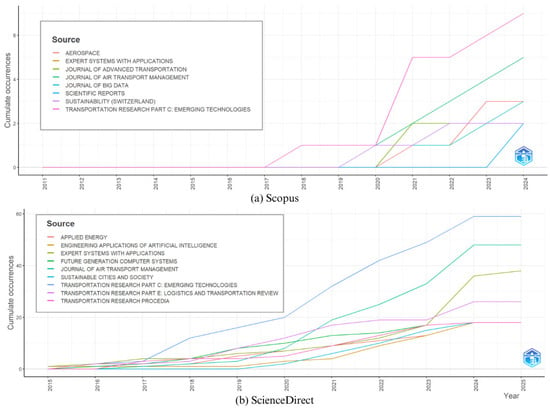
Figure 1
Open AccessArticle
Red Brick Powder-Based CoFe2O4 Nanocomposites as Heterogeneous Catalysts for Degrading Methylene Blue Through Activating Peroxymonosulfate
by
Chuqiao Sha, Fangkui Cheng, Shen Luo, Chao Zhou and Hong Zhang
Sustainability 2025, 17(21), 9886; https://doi.org/10.3390/su17219886 - 5 Nov 2025
Abstract
CoFe2O4 loaded onto red brick powder (CoFe2O4@RBP) was synthesized via coprecipitation followed by post-calcination and employed as a heterogeneous catalyst to activate peroxymonosulfate (PMS) for the degradation of methylene blue (MB), thereby valorizing red brick demolition
[...] Read more.
CoFe2O4 loaded onto red brick powder (CoFe2O4@RBP) was synthesized via coprecipitation followed by post-calcination and employed as a heterogeneous catalyst to activate peroxymonosulfate (PMS) for the degradation of methylene blue (MB), thereby valorizing red brick demolition waste within a circular economy pathway and aligning the study with sustainability-oriented resource recovery. The effects of pH, PMS concentration, catalyst dosage, and coexisting substances on MB removal were systematically investigated. Complete MB removal was achieved within 30 min, and the apparent rate constant for the CoFe2O4@RBP/PMS system was 0.22 min−1—slightly lower than that of CoFe2O4/PMS—while Co leaching was markedly reduced. The process performed well across a broad pH range (3.0–9.0). EPR and radical-quenching experiments indicate that SO4•− and HO• play a minor role, whereas the Co(II)–PMS complex is primarily responsible for MB degradation; accordingly, common coexisting species (SO42−, Cl−, NO3−, humic acid) exert negligible effects. The catalyst also maintained strong durability across numerous repetitions. These results highlight a cost-efficient route to PMS activation by coupling CoFe2O4 with construction waste-derived supports.
Full article
Open AccessArticle
Distribution of Presumably Contaminating Elements (PCEs) in Roadside Agricultural Soils and Associated Health Risks Across Industrial, Peri-Urban, and Research Areas of Bangladesh
by
Md. Sohel Rana, Qingyue Wang, Miho Suzuki, Weiqian Wang, Yugo Isobe, Afia Sultana and Tochukwu Oluwatosin Maduka
Sustainability 2025, 17(21), 9885; https://doi.org/10.3390/su17219885 - 5 Nov 2025
Abstract
Agricultural soils near roadways are increasingly contaminated with presumably contaminating elements (PCEs), raising concerns for food safety and health risks in Bangladesh. This study quantified Mn, As, Co, Cr, Zn, Ni, Cu, Cd and Pb in roadside agricultural farm soils at three depths
[...] Read more.
Agricultural soils near roadways are increasingly contaminated with presumably contaminating elements (PCEs), raising concerns for food safety and health risks in Bangladesh. This study quantified Mn, As, Co, Cr, Zn, Ni, Cu, Cd and Pb in roadside agricultural farm soils at three depths (0–5, 5–10, 10–15 cm) across industrial, peri-urban, and research areas using ICP-MS. The average mass fractions ranked as Mn > Zn > Cr > Ni > Cu > Pb > Co > As > Cd with peri-urban soils exhibiting the elevated levels of Cr (80.48 mg.kg−1 and Ni (65.81 mg.kg−1). Contamination indices indicated Cd (Contamination Factor: 2.01–2.53) and Ni (Contamination Factor: up to 2.27) as the most enriched elements, with all sites showing a Pollution Load Index (PLI) >1 (1.07–1.66), reflecting cumulative soil deterioration. Cd posed moderate ecological risk (Er: 60.3–75.9), whereas other PCEs were low risk. Health risk assessment showed elevated non-carcinogenic hazard indices (HI: 7.87–10.5 for children; 3.72–4.78 for adults), with Mn, Cr, and Co as major contributors. Cumulative carcinogenic risk (CCR) values were dominated by Cr, reaching 7.22 × 10−4 in industrial areas and 3.98 × 10−4 in peri-urban areas, exceeding the acceptable range (10−6–10−4). Metal mass fractions were consistently higher in surface soils (0–5 cm) than at deeper layers, indicating anthropogenic deposition from traffic and industry. Multivariate analysis distinguished geogenic (Cr-Ni-Cu; Mn-Co-As) from anthropogenic (Cd-Pb-Zn) sources. These findings identify Cd and Cr as priority pollutants, highlighting the need for soil management and pollution control near roadways in Bangladesh.
Full article
Open AccessArticle
Soil Organic Carbon Modelling with Different Input Variables: The Case of the Western Lowlands of Eritrea
by
Tumuzghi Tesfay, Elsayed Said Mohamed, Igor Yu. Savin, Dmitry E. Kucher, Nazih Y. Rebouh and Woldeselassie Ogbazghi
Sustainability 2025, 17(21), 9884; https://doi.org/10.3390/su17219884 - 5 Nov 2025
Abstract
In Eritrea, efforts are being made to tackle the widespread land degradation and promote natural resources and the agricultural sector. However, these efforts lack digital resources assessment, mapping, planning and monitoring. Thus, we developed soil organic carbon (SOC) predictor models for the Western
[...] Read more.
In Eritrea, efforts are being made to tackle the widespread land degradation and promote natural resources and the agricultural sector. However, these efforts lack digital resources assessment, mapping, planning and monitoring. Thus, we developed soil organic carbon (SOC) predictor models for the Western Lowlands of the country, employing 6 machine learning models with different input variables (36, 27, 15, and 08) obtained following these variables selection strategies: (1) all proposed SOC predictor variables; (2) very high multicollinearity (≥0.900 **) reduction; (3) high multicollinearity (≥0.700 **) reduction; (4) the Boruta feature selection algorithm. The results revealed that SOC levels were generally low (mean = 0.43%). Grazing lands, rainfed croplands, and irrigated farmlands all exhibited similarly low SOC values, attributed to unsustainable land management practices that deplete soil nutrients. In contrast, natural forestlands exhibited significantly higher SOC concentrations, highlighting their potential for soil carbon sequestration. Among the tested models, the XGBoost algorithm using 27 covariates achieved the highest predictive performance (RMSE = 0.118, R2 = 0.758, RPD = 2.252), whereas the multiple linear regression (MLR) model with 8 variables yielded the lowest performance (RMSE = 0.141, R2 = 0.742, RPD = 1.883). Compared to the Boruta-based feature selection, the MLR, PLS, XGBoost, Cubist, and GB models showed performance improvements of 10.41%, 10.06%, 6.72%, 6.50%, and 3.15%, respectively. Rainfall emerged as the most influential predictor of SOC spatial variability in the study area. Other important predictors included temperature, soil taxonomy, SWIR2 and NIR bands from Landsat 8 imagery, as well as sand and clay contents. We conclude that reducing very high multicollinearity is essential for improving model performance across all tested algorithms, while reducing moderate multicollinearity is not consistently necessary. The developed SOC prediction models demonstrate robust predictive capabilities and can serve as effective tools for supporting soil fertility management, land restoration planning, and climate change mitigation strategies in the Western Lowlands of Eritrea.
Full article
(This article belongs to the Special Issue Adoption of New Technologies and Practices for Sustainable and Smart Agriculture)
Open AccessArticle
A Spatiotemporal Forecasting Method for Cooling Load of Chillers Based on Patch-Specific Dynamic Filtering
by
Jie Li, Zhengri Jin and Tao Wu
Sustainability 2025, 17(21), 9883; https://doi.org/10.3390/su17219883 - 5 Nov 2025
Abstract
Accurate cooling load forecasting in chiller units is critical for building energy optimization, yet remains challenging due to non-stationary nonlinear dynamics driven by coupled external weather variability (solar radiation, ambient temperature) and internal thermal loads. Conventional models fail to capture the spatiotemporal coupling
[...] Read more.
Accurate cooling load forecasting in chiller units is critical for building energy optimization, yet remains challenging due to non-stationary nonlinear dynamics driven by coupled external weather variability (solar radiation, ambient temperature) and internal thermal loads. Conventional models fail to capture the spatiotemporal coupling inherent in load time series, violating their stationarity assumptions. To address this, this research proposes OptiNet, a spatiotemporal forecasting framework integrating patch-specific dynamic filtering with graph neural networks. OptiNet partitions multi-sensor data into non-overlapping time patches to develop a dynamic spatiotemporal graph. A learnable routing mechanism then performs adaptive dependency filtering to capture time-varying temporal–spatial correlations, followed by graph convolution for load prediction. Validated on long-term industrial logs (52,075 multi-sensor samples at 20 min; district cooling plant in Zhangjiang, Shanghai, with multiple chillers, towers, pumps, building meters, and a weather station), OptiNet achieves consistently lower MAE and MSE than Graph WaveNet across 6–144-step horizons and sampling frequencies of 20–60 min; among 30 set-tings it leads in 26, with MSE reductions up to 27.8% (60 min, 72-step) and typical long-horizon (72–144 steps) gains of ≈2–18% MSE and ≈1–15% MAE. Crucially, the model provides interpretable spatial–temporal dependencies (e.g., “Zone B solar radiation influences Unit 2 load with 4-h lag”), enabling data-driven chiller sequencing strategies that reduce electricity consumption by 12.7% in real-world deployments—directly advancing energy-efficient building operations.
Full article
(This article belongs to the Special Issue AI- and IoT-Driven Solutions for Industrial Sustainability and Smart Manufacturing)
Open AccessArticle
Removal of 2-Methyl-4-Isothiazolin-3-One by VUV/UV/Persulfate for Sustainable Wastewater Reclamation: Effects of Inorganic Anions on the Concentrations and Contributions of Hydroxyl Radicals and Sulfate Radicals
by
Yi-Fan Zhang, Hong-Wei Xu and Nan Huang
Sustainability 2025, 17(21), 9882; https://doi.org/10.3390/su17219882 - 5 Nov 2025
Abstract
The non-oxidizing antimicrobial 2-Methyl-4-Isothiazolin-3-one (MIT) poses a significant environmental risk given its frequent detection in municipal wastewater. This study showed that the combination of Vacuum UV/UV (VUV/UV) and persulfate (PDS) efficiently achieved the rapid transformation and removal of 10 μM MIT within 90
[...] Read more.
The non-oxidizing antimicrobial 2-Methyl-4-Isothiazolin-3-one (MIT) poses a significant environmental risk given its frequent detection in municipal wastewater. This study showed that the combination of Vacuum UV/UV (VUV/UV) and persulfate (PDS) efficiently achieved the rapid transformation and removal of 10 μM MIT within 90 s, which is much faster than UV, UV/PDS, and VUV/UV. Increasing the PDS dosage improved MIT degradation, whereas changes in pH between 4 and 10 had little effect. Radical quenching experiments showed that 93% of the MIT oxidation was attributable to the hydroxyl radical (•OH) and the sulfate radical (SO4•−). SO4•− and •OH at concentrations of 8.6 × 10−12 M and 1.5 × 10−12 M accounted for 32% and 61% of the MIT degradation, respectively, and the greater contribution of •OH was attributed to its higher reaction rate constant with MIT compared to SO4•−. Sulfate had a negligible impact on the radical concentrations. Chloride (1 mM) reduced the SO4•− and •OH concentrations by 61% and 27%, respectively. And the SO4•− contribution to MIT degradation fell to 19%. Nitrate (5 mM) readily quenched •OH but minimally affected SO4•−. The •OH concentration decreased by 79%, reducing its contribution to 27%. Bicarbonate/carbonate (5 mM) simultaneously reduced the SO4•− and •OH by 26–30% and had little effect on their contributions. Because of the quenching effect of organic matter and inorganic anions on radicals, secondary effluent inhibited the degradation of MIT. After a 120 s treatment, the total organic carbon, UV254, and fluorescence regional integration were reduced by 5%, 8%, and 17–24%, respectively. This study provides a quantitative analysis of how inorganic ions alter the concentrations and contributions of •OH and SO4•−, elucidating the MIT removal mechanisms in VUV/UV/PDS for sustainable wastewater reclamation.
Full article
(This article belongs to the Topic Advanced Oxidation Processes for Wastewater Purification)
►▼
Show Figures
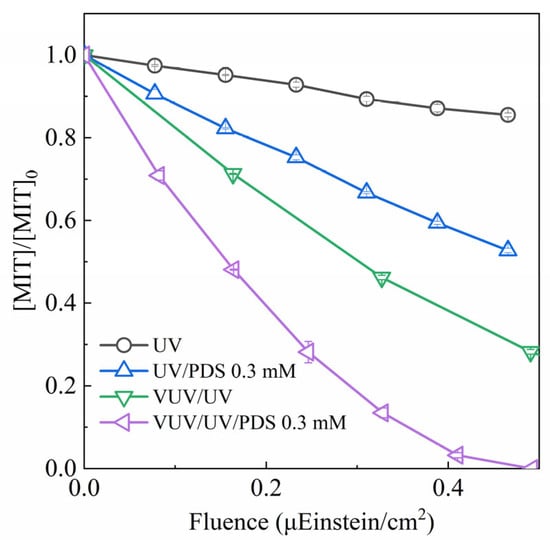
Figure 1
Open AccessArticle
Natural Hazard Resilience in the Western Mediterranean: Insights from Urban Planning in Morocco
by
Abdelaaziz El Kouffi and Younes El Kharim
Sustainability 2025, 17(21), 9881; https://doi.org/10.3390/su17219881 - 5 Nov 2025
Abstract
Resilience through urban planning has gained prominence since the adoption of the Sendai Framework for Disaster Risk Reduction (2015–2030), particularly in regions exposed to multiple natural hazards. This study examines how six Western Mediterranean countries—Spain, France, Italy, Tunisia, Algeria, and Morocco—address disaster risk
[...] Read more.
Resilience through urban planning has gained prominence since the adoption of the Sendai Framework for Disaster Risk Reduction (2015–2030), particularly in regions exposed to multiple natural hazards. This study examines how six Western Mediterranean countries—Spain, France, Italy, Tunisia, Algeria, and Morocco—address disaster risk prevention through urban and spatial planning. Although these countries share a similar geodynamic and climatic context, their approaches to integrating hazard prevention into planning frameworks vary significantly due to institutional, technical, and legal factors. Special attention is given to the case of Morocco, where delays in hazard integration are evident, particularly in the Maghreb region. Limited access to historical data, weak inter-agency coordination, and insufficient scientific capacity hinder effective planning. In response, Morocco has developed the Urbanization Suitability Map (USM) program, a non-binding planning tool inspired by the French Natural Risk Prevention Plan (PPRN). The USM tool overlays hazard information to guide land use decisions and mitigate risks such as floods, landslides, and seismic activity. Using a qualitative comparative analysis of regulatory texts, national planning strategies, and mapping instruments, this study identifies contrasting levels of disaster risk reduction integration across the six countries. The Moroccan USM initiative stands out as a pragmatic response to governance gaps and offers a transferable model for other countries with similar constraints. The findings underscore the need for clearer legislation, improved data systems, and multi-level coordination to enhance urban resilience. Recommendations are provided to strengthen hazard-informed planning practices and support more adaptive and sustainable land management in risk-prone areas.
Full article
(This article belongs to the Section Sustainable Management)
►▼
Show Figures
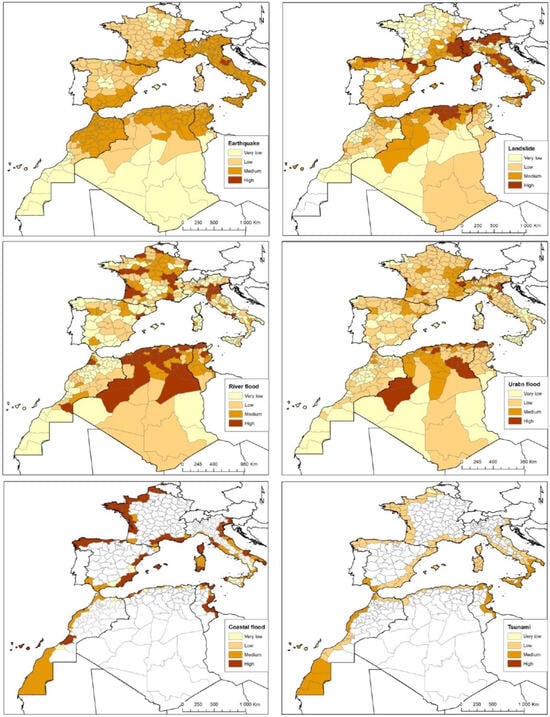
Figure 1
Open AccessArticle
Knowledge Loss in Construction Project-Based Organizations: The Role of Project Features, Knowledge Withholding, Fear, and Teams Interaction
by
Beatrice Audifasi Nyallu, Xiaopeng Deng and Abubakar Sadiq Ibrahim
Sustainability 2025, 17(21), 9880; https://doi.org/10.3390/su17219880 - 5 Nov 2025
Abstract
Knowledge loss (KL), the disappearance of critical knowledge once a project ends, remains a persistent threat to the sustainability of organizational performance and competitiveness despite ongoing efforts to implement knowledge retention (KR) methods in construction organizations. This study presents a new research model
[...] Read more.
Knowledge loss (KL), the disappearance of critical knowledge once a project ends, remains a persistent threat to the sustainability of organizational performance and competitiveness despite ongoing efforts to implement knowledge retention (KR) methods in construction organizations. This study presents a new research model to examine why KL occurs and how valuable project knowledge can be effectively retained. From the conservation of resources (COR) perspective, we aim to investigate how project urgency and temporariness, referred to as project features (PFs), influence knowledge loss through members’ knowledge withholding (KW) behavior, how this association is affected by their psychological emotions (fears), and the contingent role relational resources, namely project team interaction (PTI), plays in this association. Data were collected from a sample of 469 construction experts with extensive experience in international engineering projects undertaken by Chinese international companies. Partial least squares path modeling (PLS-PM) analysis using SmartPLS 4 was employed to empirically test the proposed theoretical model. The results show that KW behavior is a critical driver of KL and serves as a mediator of the impact of PFs on KL. PFs were found to be positively associated with members’ KW behavior. This linkage was partially mediated by fear of failure (FF), while fear of losing uniqueness (FLU) showed no significant mediating effect. PTI played a moderating role in the relationship between KW and KL. Based on these findings, minimizing KL requires management to focus on reducing FF by fostering a climate of mistake tolerance, and subsequently strengthening PTI to promote effective knowledge exchange. The results of this study offer new theoretical and practical insights into KL risk management within construction organizations.
Full article
Open AccessArticle
The Impact of AI on Digital Quality and Technical Sustainability of Travel Websites
by
Teodora Maria Begu, Simona Soica and Anisor Nedelcu
Sustainability 2025, 17(21), 9879; https://doi.org/10.3390/su17219879 - 5 Nov 2025
Abstract
The tourism industry is currently experiencing a substantial digital transformation, with Online Travel Agencies (OTAs) committed to integrating innovations such as artificial intelligence (AI) in order to enhance service delivery and personalize user experiences. This study investigates the relationship between the utilization of
[...] Read more.
The tourism industry is currently experiencing a substantial digital transformation, with Online Travel Agencies (OTAs) committed to integrating innovations such as artificial intelligence (AI) in order to enhance service delivery and personalize user experiences. This study investigates the relationship between the utilization of AI and the technical quality scores of tourism websites, aiming to identify significant associations and variances in the critical conversion phase. An exploratory research design is employed to evaluate the technical quality of three prominent international tourism websites, i.e., Booking.com, Airbnb.com, and Tripadvisor.com. The investigation uses Google Lighthouse, with Performance, Accessibility, Best Practices, and Search Engine Optimization (SEO) as variables analyzed across both desktop and mobile versions, as well as on pages with and without AI functionality. Data analysis is performed using JASP (version 0.19.3), including linear regression analysis to quantify the predictive relationship. The analysis confirms that the Performance variable is the most sensitive to the influence of AI. AI integration demonstrates a significant positive influence on the Performance score of travel websites. The regression model indicates that AI usage explains 78.9% of the variation in the Performance score (
(This article belongs to the Special Issue Marketing and Artificial Intelligence in Tourism Management)
►▼
Show Figures
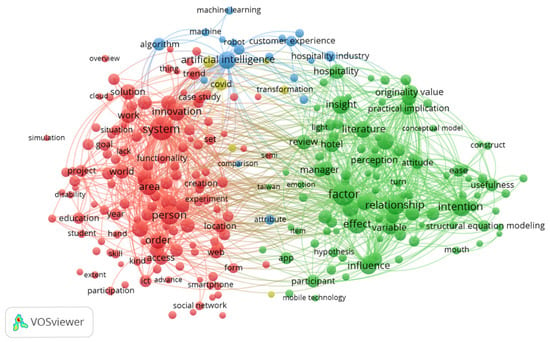
Figure 1
Open AccessArticle
Resilience and Liveability as Drivers of Sustainability: The Case of UBC’s Public Spaces
by
Marichela Sepe
Sustainability 2025, 17(21), 9878; https://doi.org/10.3390/su17219878 - 5 Nov 2025
Abstract
Environmental sustainability and resilience have become urgent priorities in contemporary urban planning as cities confront the disruptive impacts of climate change, extreme weather, and global health crises. Within this framework, university campuses increasingly act as catalysts for sustainable urban transformation. This research, developed
[...] Read more.
Environmental sustainability and resilience have become urgent priorities in contemporary urban planning as cities confront the disruptive impacts of climate change, extreme weather, and global health crises. Within this framework, university campuses increasingly act as catalysts for sustainable urban transformation. This research, developed within the LOVE Sapienza and NARRATES projects, seeks to identify the key factors that enhance the liveability of campus public spaces and to propose a dedicated methodology, supported by the case study of the University of British Columbia (UBC) in Vancouver. The proposed approach integrates spatial analyses, field observations, and perceptual mapping aligned with the principles of the Charter for Resilient and Liveable Public Spaces. UBC exemplifies how biophilic design, inclusive governance, and art-based placemaking can strengthen resilience, social cohesion, and cultural identity. The study contributes a transferable framework for designing and managing campus public spaces as drivers of sustainability and urban regeneration.
Full article
(This article belongs to the Special Issue Spatial Analysis and Spatial Planning for Sustainability in Urban Areas)
Open AccessArticle
Digital Twin-Driven Low-Carbon Service Design and Modularization in Central Air Conditioning Ecosystems: A Multi-Criteria and Co-Intelligence Approach
by
Yong Cao and Xinguo Ming
Sustainability 2025, 17(21), 9877; https://doi.org/10.3390/su17219877 - 5 Nov 2025
Abstract
The urgent global mandate for carbon neutrality necessitates a shift from traditional product-centric models towards Digital Twin (DT)-driven low-carbon service solutions, particularly in Central Air Conditioning (CAC) systems. This paper proposes a novel DT-driven framework for systematic low-carbon service design and modularization in
[...] Read more.
The urgent global mandate for carbon neutrality necessitates a shift from traditional product-centric models towards Digital Twin (DT)-driven low-carbon service solutions, particularly in Central Air Conditioning (CAC) systems. This paper proposes a novel DT-driven framework for systematic low-carbon service design and modularization in CAC ecosystems. The framework first facilitates a comprehensive demand analysis, informed by a three-dimensional Energy Scenario Intelligence model and quantified using robust multi-criteria methods. The framework then introduces a novel methodology for the quantitative analysis of co-intelligence relationships, which provides the foundation for an advanced service module generation and optimization approach that leverages an improved Girvan Newman algorithm and Interval Type-2 Fuzzy TOPSIS to handle high-level uncertainties. A key contribution is the explicit elucidation of DT’s pivotal role in enabling predictive and systemic low-carbon capabilities. The framework’s effectiveness was verified in an intelligent office building, achieving a 74.29% integrated energy saving rate and an annual carbon reduction of 618.5 tCO2. The findings offer valuable theoretical insights and a practical methodology for designing and implementing sustainable CAC service ecosystems.
Full article
Open AccessArticle
The Influence of CO2 Injection Timing and Well Placement on Storage Indicators in a Producing Natural Gas Reservoir with High CO2 Content
by
Domagoj Vulin, Lucija Jukić, Valentina Kružić and Ante Dujaković
Sustainability 2025, 17(21), 9876; https://doi.org/10.3390/su17219876 - 5 Nov 2025
Abstract
Carbon capture and storage is recognized as the best method for CO2 emission mitigation in cases where the emissions cannot be avoided by switching to renewable energy or by increasing efficiency. In the Republic of Croatia, there are a number of gas-condensate
[...] Read more.
Carbon capture and storage is recognized as the best method for CO2 emission mitigation in cases where the emissions cannot be avoided by switching to renewable energy or by increasing efficiency. In the Republic of Croatia, there are a number of gas-condensate reservoirs with a high content of CO2 that are adequate candidates for CO2 storage. The injection starts at selected different points before the end of production and might bring financial benefits as a result of CO2 injection patterns and efficient permanent storage. Employing a model of a typical reservoir, various scenarios of CO2 injection are examined to assess the impact of injection well positioning and timing on the reservoir’s sustainability for permanent CO2 storage. The main indicators used for the assessment are additional hydrocarbon recovery, retention, and storability.
Full article
(This article belongs to the Special Issue Carbon Capture, Utilization, and Storage (CCUS) for Clean Energy)
►▼
Show Figures
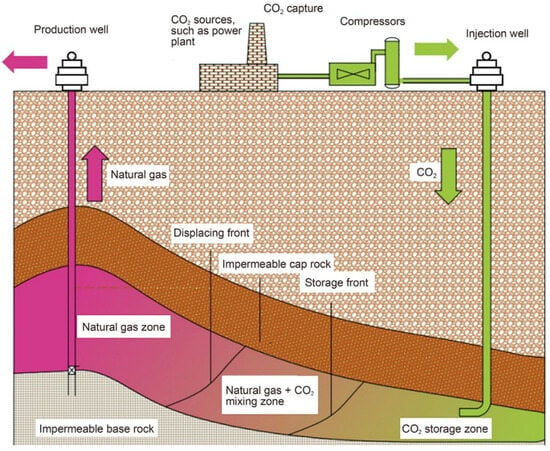
Figure 1
Open AccessArticle
Manure Application and Energy Potential in Southeastern China
by
Yufeng Wang, Hua Deng and Chih-Chun Kung
Sustainability 2025, 17(21), 9875; https://doi.org/10.3390/su17219875 - 5 Nov 2025
Abstract
China has promoted renewable energy development to adjust its energy structure and improve energy security. The decision-makers consider manure-to-energy a feasible possibility because manure contains a substantial amount of organic materials that are potentially useful for generating power, and its use would also
[...] Read more.
China has promoted renewable energy development to adjust its energy structure and improve energy security. The decision-makers consider manure-to-energy a feasible possibility because manure contains a substantial amount of organic materials that are potentially useful for generating power, and its use would also alleviate environmental pressures. Southern China, including Anhui, Fujian, Guangdong, and Zhejiang provinces, has launched policies to support manure facilities and energy sales. This study employs a lifecycle analysis and techno-economic assessment to evaluate whether manure application could be an economically feasible alternative. The results indicate that the thermophilic system has greater energy potential, and the mesophilic mode can yield greater agronomic benefits with digestate application. Hog manure can generate biopower ranging from 5599 to 5683 GWh, and it is 653 to 1887 GWh for cattle, 2481 to 2963 GWh for poultry manure, and 1109 to 1536 GWh for sheep manure. The aggregate emission offset could also be substantial. If all manures are properly utilized, the net emission offset could be up to 12.07 million metric tons of CO2 equivalent, with an aggregate energy revenue of approximately USD 1086 million annually. In addition to the aggregate result, this study also indicates that manure application would yield a profit ranging from USD 8.36 to USD 34.3, and the benefit from biofertilizer would be roughly between USD 27.72 and USD 43.49. Nevertheless, regional characteristics, such as temperature, precipitation, and soil quality, generally influence agricultural systems, and the benefits associated with agrarian feedback would involve a higher uncertainty. On the contrary, energy sales could be considered a more reliable and stable source of income, even without government subsidies.
Full article
(This article belongs to the Special Issue Towards Sustainability: Advances in Renewable Energy Policy and Environmental Economics)
Open AccessArticle
The Influence of Socio-Demographic Factors on the Sustainable Consumption of Organic Vegetables in Romania
by
Diana Maria Ilie, Valentina Constanta Tudor, Rozi Liliana Berevoianu, Marius Mihai Micu, Vili Dragomir and Steliana Rodino
Sustainability 2025, 17(21), 9874; https://doi.org/10.3390/su17219874 - 5 Nov 2025
Abstract
This study analyzes how socio-demographic factors influence the sustainable consumption of organic vegetables in Romania. Following behavioral theories such as the Theory of Planned Behavior and Value-Belief-Norm models, the study explores how attitudes, trust, and socio-demographic characteristics shape individual purchasing decisions. The main
[...] Read more.
This study analyzes how socio-demographic factors influence the sustainable consumption of organic vegetables in Romania. Following behavioral theories such as the Theory of Planned Behavior and Value-Belief-Norm models, the study explores how attitudes, trust, and socio-demographic characteristics shape individual purchasing decisions. The main objective was to analyze the frequency of consumption of organic vegetables, the reasons for action, the level of trust in organic certification and preferences regarding distribution channels in relation to socio-demographic variables. The research was based on a structured questionnaire applied to a sample of 533 respondents, selected from various regions of the country. The statistical analysis included descriptive and inferential methods, namely the Chi-square test for the association between variables, the Spearman coefficient for ordinal correlations and the Mann–Whitney U test for the comparison of independent groups. Results show that the frequency of organic vegetable consumption decreases as income and education rise, a pattern influenced by Romania’s market structure and cultural context, where higher-income consumers often prefer imported or internationally certified products, while middle-income groups sustain local purchases. Health is the main motivation for the purchase, while aspects related to environmental protection and support for local producers are mentioned secondarily. Price perception is significantly associated with age, income, and education, and the preference for purchasing channels especially depends on educational level. Trust in producers correlates with gender and income, while trust in certification labels shows no significant associations. These findings provide insight into how socio-demographic characteristics shape sustainable consumption behaviors and build a solid foundation for the development of the organic products market in Romania.
Full article
(This article belongs to the Special Issue Agricultural Economics, Policies, and Rural Development for Sustainability)
Open AccessArticle
The Nexus Between Indoor and Outdoor Environmental Conditions and Teacher Perceptions in Naturally Ventilated Primary School Classrooms, in Ireland
by
David Honan, John Garvey, John Littlewood, Matthew Horrigan and John Gallagher
Sustainability 2025, 17(21), 9873; https://doi.org/10.3390/su17219873 - 5 Nov 2025
Abstract
Indoor air quality (IAQ) and thermal comfort influence the health and cognitive performance of school occupants. This study investigated carbon dioxide (CO2), nitrogen dioxide (NO2), thermal comfort, and ventilation rates (VRs) in eight naturally ventilated (NV) primary school classrooms
[...] Read more.
Indoor air quality (IAQ) and thermal comfort influence the health and cognitive performance of school occupants. This study investigated carbon dioxide (CO2), nitrogen dioxide (NO2), thermal comfort, and ventilation rates (VRs) in eight naturally ventilated (NV) primary school classrooms in Ireland during October 2024, combining environmental monitoring with teacher surveys. Mean CO2 concentrations ranged from 796 ppm to 2469 ppm, exceeding national guidelines in seven of the eight classrooms. NO2 levels ranged from 3.4 µg/m3 to 7.2 µg/m3, with indoor/outdoor ratios increasing with VRs and influenced by window orientation and road proximity. Indoor temperatures remained within recommended limits, while relative humidity ranged from 53% to 78% mirroring CO2 trends and exceeding guideline levels in classrooms with lower VRs and temperatures. Occupied VRs ranged from 1.2 l/p/s to 4.1l/p/s with window opening behaviours, reliant on teachers’ perceptions of thermal comfort, accounting for 84% to 96% of VRs. Ventilation in NV classrooms is often insufficient, yet increasing VRs can compromise thermal comfort and increase ingress of outdoor pollutants and noise. The findings highlight the ineffectiveness of current school ventilation standards, which rely heavily on user operation. Integrating occupant-led strategies, including scheduled purging, awareness campaigns, and pre-emptive air quality alerting, into policy offers practical, immediate pathways to improving IAQ, fostering healthy, sustainable learning environments.
Full article
(This article belongs to the Topic Indoor Air Quality and Built Environment)
Open AccessArticle
Optimizing Sustainable and Resilient Electric Vehicle Battery Recycling Network: Insights from Fourth-Party Logistics
by
Mingqiang Yin, Zhaolin Zhang, Liyan Wang, Xiwang Guo, Xiaohu Qian and Muhammad Kamran
Sustainability 2025, 17(21), 9872; https://doi.org/10.3390/su17219872 - 5 Nov 2025
Abstract
With the increasing scarcity of critical resources, competition in the electric vehicle battery (EVB) recycling market has intensified, and the strategic establishment of efficient and resilient recycling networks is increasingly vital for maintaining raw material security. Although existing studies have explored electric vehicle
[...] Read more.
With the increasing scarcity of critical resources, competition in the electric vehicle battery (EVB) recycling market has intensified, and the strategic establishment of efficient and resilient recycling networks is increasingly vital for maintaining raw material security. Although existing studies have explored electric vehicle battery recycling network design (EVBRND), the impact of facility disruption risks on network decisions is rarely analyzed. This study explores a novel resilient EVBRND problem under disruption risk from the perspective of fourth-party logistics. To cope with disruptions, capacity backups, multi-source allocation, multiple third-party logistics (3PL), multiple transportation routes and facility fortification strategies are systematically integrated. A two-stage stochastic programming model is developed to characterize the problem, which is subsequently reformulated into a mixed-integer linear programming model using a scenario-based approach. To overcome the computational complexity resulting from the enlarged scenario set and the additional binary variables introduced by 3PL selection, a scenario reduction and decomposition-based heuristic (SRDBH) algorithm is developed, which integrates Lagrangian relaxation, conditional relaxation, scenario reduction, and the adaptive subgradient method. The proposed model and algorithm are validated through a real-world case study. Computational results confirm that the SRDBH algorithm achieves superior performance compared with CPLEX. Furthermore, sensitivity analyses highlight the critical role of flexible risk-mitigation configurations in balancing cost minimization with the enhancement of network resilience.
Full article
(This article belongs to the Section Waste and Recycling)
Open AccessArticle
The Environmental Protection Tax and Corporate Green Innovation: Evidence from China
by
Qiuyue Yin, Bingquan Yang, Chenyu Meng, Wanting Xu and Zhiyi Liu
Sustainability 2025, 17(21), 9871; https://doi.org/10.3390/su17219871 - 5 Nov 2025
Abstract
The environmental protection tax (EPT) is a vital means for China to promote sustainable development. However, its impact on corporate green innovation is controversial. Utilizing the data from Chinese A-share industrial listed companies from 2013 to 2022 and the difference-in-differences (DID) model, this
[...] Read more.
The environmental protection tax (EPT) is a vital means for China to promote sustainable development. However, its impact on corporate green innovation is controversial. Utilizing the data from Chinese A-share industrial listed companies from 2013 to 2022 and the difference-in-differences (DID) model, this study examines the impact of the EPT on corporate green innovation. The results indicate that the EPT can promote corporate green innovation, which is robust across various tests. Furthermore, the EPT fosters corporate green innovation mainly by stimulating companies to increase research and development (R&D) investment. The heterogeneity analysis demonstrates that the EPT promotes green innovation only in large-scale companies, non-state-owned companies, and eastern companies. The further analysis suggests that the green innovation brought by the EPT could improve corporate economic performance. Moreover, the EPT promotes both corporate substantive innovation and strategic innovation. That is, the EPT could enhance the quality of green innovation whilst also inducing strategic behavior. This study could provide profound insights to facilitate green transitions in emerging market countries like China.
Full article
(This article belongs to the Topic Green Technology Innovation and Economic Growth)

Journal Menu
► ▼ Journal Menu-
- Sustainability Home
- Aims & Scope
- Editorial Board
- Reviewer Board
- Topical Advisory Panel
- Instructions for Authors
- Special Issues
- Topics
- Sections & Collections
- Article Processing Charge
- Indexing & Archiving
- Editor’s Choice Articles
- Most Cited & Viewed
- Journal Statistics
- Journal History
- Journal Awards
- Society Collaborations
- Conferences
- Editorial Office
Journal Browser
► ▼ Journal BrowserHighly Accessed Articles
Latest Books
E-Mail Alert
News
Topics
Topic in
Atmosphere, Buildings, Climate, Environments, Sustainability, Earth
Climate, Health and Cities: Building Aspects for a Resilient Future
Topic Editors: Ferdinando Salata, Virgilio Ciancio, Simona MannucciDeadline: 20 November 2025
Topic in
Economies, Resources, Agriculture, Agronomy, Sustainability
Zero Hunger: Health, Production, Economics and Sustainability
Topic Editors: Richard John Roberts, José-María Montero, María del Carmen Valls Martínez, Viviane Naimy, José Manuel Santos-JaénDeadline: 30 November 2025
Topic in
Buildings, CivilEng, Energies, Sustainability
Energy Systems in Buildings and Occupant Comfort
Topic Editors: Eusébio Z. E. Conceição, Hazim B. AwbiDeadline: 20 December 2025
Topic in
Education Sciences, Future Internet, Information, Sustainability
Advances in Online and Distance Learning
Topic Editors: Neil Gordon, Han ReichgeltDeadline: 31 December 2025

Conferences
Special Issues
Special Issue in
Sustainability
Renewable Energy Technologies and Sustainable Economy
Guest Editor: Andrea MicangeliDeadline: 5 November 2025
Special Issue in
Sustainability
Sustainability in Aquaculture Systems
Guest Editor: Steven G. HallDeadline: 5 November 2025
Special Issue in
Sustainability
Environmental Education for Sustainable Futures: Past Lessons and Looking Ahead
Guest Editor: Christina MarouliDeadline: 5 November 2025
Special Issue in
Sustainability
Sustainable Building: Renewable and Green Energy Efficiency
Guest Editors: Reihaneh Aghamolaei, Mohammad Reza GhaaniDeadline: 7 November 2025
Topical Collections
Topical Collection in
Sustainability
Advanced Methodologies for Sustainability Assessment: Theory and Practice
Collection Editor: Fausto Cavallaro
Topical Collection in
Sustainability
Urban Green Infrastructure for Climate-Proof and Healthy Cities
Collection Editors: Rosemarie Stangl, Ulrike Pitha, Daniela Haluza, Ingrid Kaltenegger
Topical Collection in
Sustainability
Indicators, Assessment Tools, and Rating Systems for Mainstreaming Sustainability in Urban Planning and Development
Collection Editor: Ayyoob Sharifi
Topical Collection in
Sustainability
Sustainability in Product Development
Collection Editor: Juan Manuel Muñoz Guijosa



